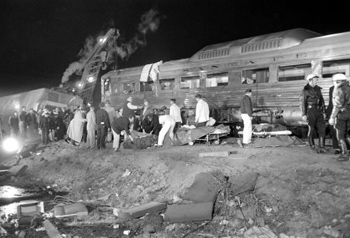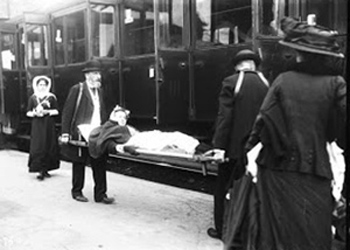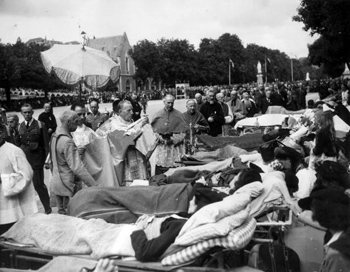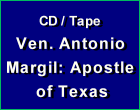Stories & Legends
 |
 |
 |
 |
 |
 |
 |
The Lourdes’ Miracle of Gabriel Gargam
The case of Gabriel Gargam is one of the best known of all the thousands of cures at Lourdes. First, because it was both a spiritual and a physical miracle; and second, because Gargam became well known at the Shrine where he volunteered for half a century as a brancardier (stretcher bearer) in thanksgiving for God’s mercy.
Gabriel Gargam was born in 1870 of good Catholic parents, but by age 15 he had lost his faith. He took a job as a traveling mail clerk of the Orleans Railway Company. He was in his thirties, carrying out his duties as a sorter in December of 1899, when the train on which he was traveling from Bordeaux to Paris collided with another train running at 50 miles per hour.
 Gargam was thrown 52 feet from the train. He lay in the snow, badly injured and unconscious for seven hours. He was paralyzed from the waist down. He was barely alive when lifted onto a stretcher. After eight months he had wasted away to a mere skeleton, weighing only 78 pounds. He could take no solid food and received nourishment by a tube only once every 24 hours.
Gargam was thrown 52 feet from the train. He lay in the snow, badly injured and unconscious for seven hours. He was paralyzed from the waist down. He was barely alive when lifted onto a stretcher. After eight months he had wasted away to a mere skeleton, weighing only 78 pounds. He could take no solid food and received nourishment by a tube only once every 24 hours.
He brought suit for damages against the railroad. The Appellate Court confirmed the verdict of the former courts and granted him 6,000 francs annually, and besides, an indemnity of 60,000 francs. Two courts attested to his condition, and the final payment of the railroad left the case a matter of record. Doctors testified that the man was a hopeless cripple for life. Previous to the accident, Gargam had not been to Church for 15 years. His aunt, who was a nun of the Order of the Sacred Heart, begged him to go to Lourdes. He refused. After the continuous pleading of his mother, however, he consented to go.
It was now two years since the accident, and he had never left his bed all that time. He was carried on a stretcher to the train. The exertion caused him to faint, and for a full hour he was unconscious. They were on the point of abandoning the pilgrimage, as it looked as if he would die on the way, but his mother insisted, and the journey was made. They arrived in Lourdes at 7 a.m. on August 20, 1901.
 That morning, he had a remarkable spiritual conversion. He went to confession and received Holy Communion. But there was no change in his physical condition. In the afternoon of the same day, he was carried to the pool to be bathed in the water. But instead of relief, his condition worsened. The exertion threw him into a swoon and he lay apparently dead.
That morning, he had a remarkable spiritual conversion. He went to confession and received Holy Communion. But there was no change in his physical condition. In the afternoon of the same day, he was carried to the pool to be bathed in the water. But instead of relief, his condition worsened. The exertion threw him into a swoon and he lay apparently dead.
After a time, as he did not revive, he was thought to be dead. On the way back to the hotel, his mother, the nurse and the brancardiers carrying Gabriel’s stretcher saw a procession of the Blessed Sacrament approaching. They stood aside to let it pass, having placed a cloth over the face of the man whom they supposed to be dead.
As the priest passed carrying the Sacred Host, he gave a Blessing to the sorrowful group around the covered body. Immediately there was a movement from under the covering. To the amazement of the bystanders, the body raised itself to a sitting posture and Gargam said in a full, strong voice, “Help me. I can walk! I feel I can walk.” These were his first spoken words since the accident. He got up and stood erect, walked a few paces and said that he was cured.
 As Gargam had on him only invalid's clothes, he returned back to the hotel. There he was soon dressed, and proceeded to walk about as if he had never been hurt. For two years hardly any food had passed his lips, but now he sat down to the table and ate a hearty meal.
As Gargam had on him only invalid's clothes, he returned back to the hotel. There he was soon dressed, and proceeded to walk about as if he had never been hurt. For two years hardly any food had passed his lips, but now he sat down to the table and ate a hearty meal.
On August 20, 1901, 60 prominent doctors examined Gargam. Speaking on behalf of the commission, Dr. Boissarie first noted the physical impossibility that the invalid could walk since he had no leg muscles after some 20 months of total paralysis of both legs and no solid food. Gabriel again stood up and walked in front of them without difficulty. The doctors pronounced him entirely cured, but were unable to explain the nature of the cure.
Gargam, out of gratitude to God in the Holy Eucharist and Our Lady, consecrated himself to the service of the invalids at Lourdes. For over 50 years he returned annually to Lourdes and worked as a brancardier.
The Golden Jubilee of his cure was the occasion of a remarkable celebration during the French National Pilgrimage in 1951. Mr. Gargam sat in a chair in the Rosary Square, surrounded by 1,500 sick and 50,000 other pilgrims while a description of his twofold miracle was given by the celebrated apologist, Canon Belleney. His last visit to the Shrine was in August 1952. He died the following March, at age 83.



Gabriel Gargam was born in 1870 of good Catholic parents, but by age 15 he had lost his faith. He took a job as a traveling mail clerk of the Orleans Railway Company. He was in his thirties, carrying out his duties as a sorter in December of 1899, when the train on which he was traveling from Bordeaux to Paris collided with another train running at 50 miles per hour.

A terrible train accident left Gargam paralyzed
He brought suit for damages against the railroad. The Appellate Court confirmed the verdict of the former courts and granted him 6,000 francs annually, and besides, an indemnity of 60,000 francs. Two courts attested to his condition, and the final payment of the railroad left the case a matter of record. Doctors testified that the man was a hopeless cripple for life. Previous to the accident, Gargam had not been to Church for 15 years. His aunt, who was a nun of the Order of the Sacred Heart, begged him to go to Lourdes. He refused. After the continuous pleading of his mother, however, he consented to go.
It was now two years since the accident, and he had never left his bed all that time. He was carried on a stretcher to the train. The exertion caused him to faint, and for a full hour he was unconscious. They were on the point of abandoning the pilgrimage, as it looked as if he would die on the way, but his mother insisted, and the journey was made. They arrived in Lourdes at 7 a.m. on August 20, 1901.

Brancardiers bearing the stretcher of a sick man at Lourdes
After a time, as he did not revive, he was thought to be dead. On the way back to the hotel, his mother, the nurse and the brancardiers carrying Gabriel’s stretcher saw a procession of the Blessed Sacrament approaching. They stood aside to let it pass, having placed a cloth over the face of the man whom they supposed to be dead.
As the priest passed carrying the Sacred Host, he gave a Blessing to the sorrowful group around the covered body. Immediately there was a movement from under the covering. To the amazement of the bystanders, the body raised itself to a sitting posture and Gargam said in a full, strong voice, “Help me. I can walk! I feel I can walk.” These were his first spoken words since the accident. He got up and stood erect, walked a few paces and said that he was cured.

A priet holding the Blessed Sacrament blesses the sick at Lourdes
On August 20, 1901, 60 prominent doctors examined Gargam. Speaking on behalf of the commission, Dr. Boissarie first noted the physical impossibility that the invalid could walk since he had no leg muscles after some 20 months of total paralysis of both legs and no solid food. Gabriel again stood up and walked in front of them without difficulty. The doctors pronounced him entirely cured, but were unable to explain the nature of the cure.
Gargam, out of gratitude to God in the Holy Eucharist and Our Lady, consecrated himself to the service of the invalids at Lourdes. For over 50 years he returned annually to Lourdes and worked as a brancardier.
The Golden Jubilee of his cure was the occasion of a remarkable celebration during the French National Pilgrimage in 1951. Mr. Gargam sat in a chair in the Rosary Square, surrounded by 1,500 sick and 50,000 other pilgrims while a description of his twofold miracle was given by the celebrated apologist, Canon Belleney. His last visit to the Shrine was in August 1952. He died the following March, at age 83.

Candles of the pilgrims make a sea of fire at a night procession at Lourdes

Adapted from Paul Glynn, Healing Fire of Christ,
Ignatius Press, 2003
Posted April 13, 2013
Ignatius Press, 2003
Posted April 13, 2013

______________________
______________________
 |
 |
 |


